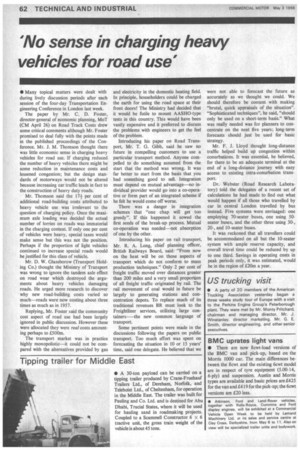'No sense in charging heavy vehicles for road use'
Page 64

If you've noticed an error in this article please click here to report it so we can fix it.
• Many topical matters were dealt with during lively discussion periods after each session of the four-day Transportation Engineering Conference in London last week.
The paper by Mr. C. D. Foster, director-general of economic planning, MoT (CM April 26) on Road Track Costs drew some critical comments although Mr. Foster promised to deal fully with the points made in the published proceedings of the Conference. Mr. J. M. Thomson thought there was little economic sense in charging heavy vehicles for road use. If charging reduced the number of heavy vehicles there might be some reduction in maintenance costs and lessened congestion; but the design standards of motorways would not be altered because increasing car traffic leads in fact to the construction of heavy duty roads.
Mr. Thomson said the 17+ per cent of additional road-building costs attributed to heavy vehicle use was irrelevant to the question of charging policy. Once the maximum axle loading was decided the actual number of lorries on roads was immaterial in the charging context. If only one per cent of vehicles were heavy, special taxes would make sense but this was not the position. Perhaps if the proportion of light vehicles continued to increase special roads would be justified for this class of vehicle.
Mr. D. W. Glassborow (Transport Holding Co.) thought the Ministry of Transport was wrong to ignore the tandem axle effect on road wear which destroyed the arguments about heavy vehicles damaging roads. He urged more research to discover why new road-building costs varied so much—roads were now costing about three times as much as in 1957.
Replying, Mr. Foster said the community cost aspect of road use had been largely ignored in public discussion. However these were allocated they were real costs amounting perhaps to £500m.
The transport market was in practice highly monopolistic—it could not be compared with the alternatives provided by gas and electricity in the domestic heating field. In principle, householders could be charged the earth for using the road space at their front doors! The Ministry had decided that it would be futile to mount AASHO-type tests in this country. This would have been vastly expensive and it preferred to discuss the problems with engineers to get the feel of the problem.
Introducing his paper on Road Transport, Mr. T. G. Gibb, said he saw no future in compelling customers to use a particular transport method. Anyone compelled to do something assumed from the start that the method was wrong. It was far better to start from the basis that you had something good to sell. Integration must depend on mutual advantage—no individual provider would go into a co-operative or form part of an integrated scheme if he felt he would come off worse.
There was a danger in integration schemes that "one chap will get too greedy". If this happened it sowed the first seeds of the break-up process. Mutual co-operation was needed—not absorption of one by the other.
Introducing his paper on rail transport, Mr. R. A. Long, chief planning officer, British Railways Board, said: "From now on the heat will be on those aspects of transport which do not conform to mass production techniques." Only 2 per cent of freight traffic moved over distances greater than 200 miles and a very small proportion of all freight traffic originated by rail. The rail movement of coal would in future be largely to generating stations and con centration depots. To replace much of its traditional revenues BR must look to the Freightliner services, utilizing large containers—the new common language of transport.
Some pertinent points were made in the discussions following the papers on public transport. Too much effort was spent on forecasting the situation in 10 or 15 years' time, said one delegate. He believed that we were not able to forecast the future as accurately as we thought we could. We should therefore be content with making "brutal, quick appraisals of the situation". "Sophisticated techniques", he said, "should only be used on a short-term basis." What was really needed was for planners to concentrate on the next five years; long-term forecasts should just be used for basic strategy.
Mr. F. J. Lloyd thought long-distance traffic helped build up congestion within conurbations. It was essential, he believed, for there to be an adequate terminal at the end of a long-distance journey with easy access to existing intra-conurbation transport.
Dr. Webster (Road Research Laboratory) told the delegates of a recent set of calculations he had made to find out what would happen if all those who travelled by car in central London travelled by bus instead. Five systems were envisaged: one employing 70-seater buses, one using 50seater buses, and the other three using 30-, 20-, and 10-seater buses.
It was reckoned that all travellers could be accommodated on all but the 10-seater system with ample reserve capacity, and overall travel time could be reduced by up to one third. Savings in operating costs in peak periods only, it was estimated, would be in the region of £20m a year.




































































































































































































































